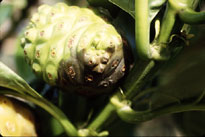
Disease noni tree in a forest understory in Puna with greater
than 95% collapsed leaves. |

Characteristic “black flags” (collapsed, necrotic
leaves) and blackened stems associated with noni black flag
disease. |

Blackened noni fruit infected with Phytophthora. |
|
(For more complete information on
noni black flag and a free online publication, visit
http://www2.ctahr.hawaii.edu/oc/freepubs/pdf/PD-19.pdf) |
|
Disease: Noni
black flag.
Pathogen: Noni black flag is caused
by a Phytophthora sp. (tentatively identified as Phytophthora
botryosa, a fungus-like organism). We do not yet know the
host range of this pathogen.
Symptoms: Foliar
symptoms of noni black flag include: black leaf spots and leaf
blight; brown to black stem blight; brown to black soft rot
of fruits; fruit mummification; severe defoliation (hanging,
diseased leaves are referred to “black flags”); blackened
leaf veins; death of stems; plant death. Roots and woody portion
of the plant are not normally infected.
Impact:
Noni black flag is a major threat to noni farms in areas where
the disease it occurs. Large yield losses and even plant death
are possible.
Disease distribution: Noni black
flag was first discovered in 2000 in the Puna district near
Opihikao on the island of Hawaii. The disease is not known to
exist elsewhere in Hawaii or in the world.
Epidemiology:
Noni black flag is favored by frequent rains, high winds, warm
weather and high relative humidity. Spores are dispersed by
splashing rain and wind.
Control: |
- Learn to recognize black flag disease symptoms and inspect
noni plants regularly during and after periods of extended
rainfall.
- Promptly prune, remove and destroy symptomatic foliage
and fruits to reduce pathogen inoculum levels and to minimize
the likelihood of disease spread.
- Remove fallen or pruned branches, stems, leaves and fruits.
Do not allow them to accumulate beneath noni trees.
- Promote air circulation within the noni canopy to ensure
rapid drying of leaves and fruits. This can be accomplished
by selecting wider plant spacing during farm establishment,
and by pruning back verticals to open up the canopy to increased
air movement.
- Reduce relative humidity within the noni canopy. Prune
back overhanging trees. Ensure good soil drainage. Control
weeds around the noni plants. These measures will ensure
rapid drying of leaves and fruits after rainfall, reduce
water congestions in plant tissues, and minimize the infective
potential of the pathogen.
- Avoid introducing diseased noni plants or fruits into
high-rainfall areas where the disease has not been reported.
Start new noni farms with disease-free plants.
|
| Notes:
Noni black flag was previously unreported to occur in Hawaii
and elsewhere in the world. |
 |

